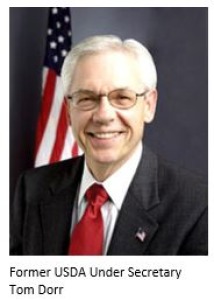Even with the passage of the new farm bill, the potential for reasonable increases in farm income seems not yet to appear on the economic horizon. Resolution of trade issues may help somewhat. Yet the damage done through the course of these trade discussions is not substantively different, and in fact may be worse, than the damage wrought by President Richard Nixon’s soybean export embargo of the 1970s.
There are two reasons driving agriculture’s inability to generate sustainable new economic growth, while simultaneously providing our competitors an outsized capability to displace U.S. agriculture’s role in the global food market.
The first is our stubborn adherence to farm programs now in existence for nearly 90 years. Although the details of the programs have changed somewhat, the form is still the same. These policies drive commodity programs, in much the same manner that Henry Ford purportedly sold his cars saying, “Any customer can have a car painted any color he wants so long as it is black.”[1]
The only difference: Henry Ford accommodated the evolving market. Commodity agriculture is still trying to sell a higher quality “black Model T.”
The second reason, beyond continued faulty policy development, is our inability to understand and capture the value of internet-driven technology. The current view of policymakers, and the resultant farm bill authorizations and appropriations, is that access to the internet is dependent on “fiber to the premises.” In today’s environment that assumption of internet access is no different than assuming you only have the option to purchase a black automobile.
Policies affecting internet access in agriculture have been largely focused on commodity production and the ancillary issues involved: auto steer, planter, sprayer, and harvest data. We’ve wasted 15 years trying to determine who owns the data and its value. Those have proven to be spurious concerns at best.
International "commodity" competitors have substantially less legacy infrastructure and land costs. Thus, they are aggressively capturing and benefiting from technologies which U.S. agricultural interests have developed. While U.S. agriculture fiddles with the modification of largely irrelevant policies, very able global competitors are making leap-frog commodity production gains at our expense.
Here is why: These new global agriculture and food market opportunities involve high-value non-commodity products. Think about how much more difficult it would be to restrict ethically acceptable, branded, high-value non-commodity products as opposed to soybeans or corn. How can you sustainably produce, track, deliver, and guarantee the quality of high-value food products? Only access to, and the use of, robust internet technology enables this value chain to exist sustainably and with consistent reliability.
The simple fact is that agriculture and food products are produced in rural areas of America. Internet connectivity to the "premises" does not provide the kind of robust, dynamic 24/7 access required at the poultry, hog, dairy, or cattle feeding barn. It doesn’t provide the required needs of those producing high-value products in the fruit, vegetable, or nut farms.
If we want high-quality branded and differentiated products to be the opportunities of the future for the food and agricultural industry, we must have the ability to produce, process, track, and defend our use of the environment and the integrity of the high-value products we present to the global market.
Certain Georgia onion producers can produce sweet onions anywhere in the world and track how they were produced. From the time the onions are planted until they are mechanically cleaned, sorted, and stamped with an SKU tag, the producer has the technology to provide customers all the verifiable information needed to assure them of the quality and sustainability of the product.
Quality and sustainability are the keys to the next level of agricultural profitability. In the case of the onion producer, he can control all data collection and management. Yet how many animal barns can monitor and report air quality, particulate emissions, animal health, water quality and consumption, feed consumption, and overall infrastructure conditions in a real-time manner? How many tile water sensors can be installed and monitored to obtain real-time data? How many fertilizer, pesticide, or manure applicators can report real-time operations to a database capable of analyzing and providing suggestions, alerts, or solutions?
The next generation of economic prosperity in rural America must be driven by sustainable value-added agriculture. The only means to accomplish and validate the effort and resultant products are to aggressively deploy Generation 5 WiFi across Rural America.
This will require a change in mindset. It will obviate many of the proposed wired and already depreciated fiber to the premises' assets. We don’t have time to debate how the policies will affect existing legacy strategies before deploying 1-3 pilot projects over appropriately selected areas. These pilots should be placed in areas without and with existing fiber to the premise. However, those with fiber of some sort will still be largely underserved. The pilots should encompass 3-5 townships and would serve to determine the cost, efficacy, and potential of Gen 5 WiFi in these areas.
The technologies to legitimately capture significant shares of the value-added food market, and thus renewed profitability, for rural America are cost-effective and available. We must proceed with this effort and the resultant policy discussions in a 21st century framework ... not one wrapped around a nearly 10-decade-old policy embracing out-of-date commodity-focused premises. This is an urgent need requiring the kind of “skunk works” mentality that I know already exists and can be delivered by rural entrepreneurs.
[1] “Henry Ford – My life and work”
[2] Agriculture and Nutrition Act of 2018
About the author: Tom Dorr is an Iowa farmer who has formerly served as USDA Undersecretary for Rural Development and CEO of the U.S. Grains Council.


